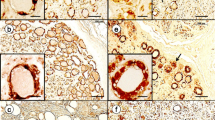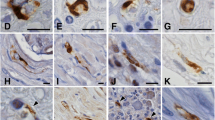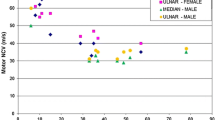Abstract
Friedreich’s ataxia (FRDA) causes a complex neuropathological phenotype with characteristic lesions of dorsal root ganglia (DRG); dorsal spinal roots; dorsal nuclei of Clarke; spinocerebellar and corticospinal tracts; dentate nuclei; and sensory nerves. This report presents a systematic morphological analysis of sural nerves obtained by autopsy of six patients with genetically confirmed FRDA. The outstanding lesion consisted of lack of myelinated fibers whereas axons were present in normal numbers. On cross-sections, only 11% of all class III-β-tubulin-positive axons were myelinated in FRDA, contrasting with 36% in normal control nerves. Despite their paucity, thin myelinated fibers assembled compact sheaths containing the peripheral myelin proteins PMP-22, P0, and myelin basic protein. The nerves displayed major modifications in Schwann cells that were apparent by laminin 2 and S100α immunocytochemistry. Few S100α-immunoreactive cells remained detectable whereas laminin 2 reaction product was abundant. The normal honeycomb-like distribution of laminin 2 around myelinated fibers was replaced by confluent regions of reaction product that enveloped clusters of closely apposed thin axons. Electron microscopy not only confirmed the lack of myelin but also showed abnormal Schwann cells and axons. Ferritin localized to normal Schwann cell cytoplasm. In the sensory nerves of patients with FRDA, the distribution of this protein strongly resembled laminin 2, but there was no net increase of the total ferritin-reactive area. Ferroportin reaction product occurred in all axons of sural nerves in FRDA, which was at variance with dorsal spinal roots. In the pathogenesis of sensory neuropathy in FRDA, two mechanisms are likely: hypomyelination due to faulty interaction between axons and Schwann cells; and slow axonal degeneration. Neurons of DRG, satellite cells, Schwann cells, and axons of sensory nerves and dorsal spinal roots derive from the neural crest, and hypomyelination in FRDA may be attributed to defects of regulation or migration of shared precursor cells. Sural nerves in FRDA showed no convincing change in ferritin and ferroportin, militating against local iron dysmetabolism. The result stands out in contrast to the previously reported changes in dorsal spinal roots of patients with FRDA.








Similar content being viewed by others
References
Bidichandani SI, Garcia CA, Patel PI, Dimachkie MM (2000) Very late-onset Friedreich ataxia despite large GAA triplet repeat expansions. Arch Neurol 57:246–251
Bradley WG, Jenkison M (1973) Abnormalities of peripheral nerves in murine muscular dystrophy. J Neurol Sci 18:227–247
Caruso G, Santoro L, Perretti A, Serienga L, Crisci C, Ragno M, Barbieri F, Filla A (1983) Friedreich’s ataxia: electrophysiological and histological findings. Acta Neurol Scand 67:26–40
Ciannetti L, Segnalini P, Calzolari A, Morsilli O, Felicetti F, Ramoni C, Gabbianelli M, Testa U, Sposi NM (2005) Expression of alternative transcripts of ferroportin-1 during human erythroid differentiation. Haematologia 90:1595–1606
Dejerine J, Thomas A (1907) Les lésions des racines, des ganglions rachidiens et des nerfs dans un cas de maladie de Friedreich. Rev Neurol 15:41–54
Di Muzio A, De Angelis MV, Di Fulvio P, Ratti A, Pizzuti A, Stuppia L, Gambi D, Uncini A (2003) Dysmyelinating sensory-motor neuropathy in merosin-deficient congenital muscular dystrophy. Muscle Nerve 27:500–506
Du X-J, Cole TJ, Tenis N, Gao X-M, Köntgen F, Kemp BE, Heierhorst J (2002) Impaired cardiac contractility response to hemodynamic stress in S100A1-deficient mice. Mol Cell Biol 22:2821–2829
Dyck PJ, Lais AC (1974) Evidence for segmental demyelination secondary to axonal degeneration in Friedreich’s ataxia. In: Kakulas BA (ed) Clinical studies in myology. Proceedings of the second international congress on muscle diseases. Excerpta Medica, Amsterdam, pp 253–263
Dyck PJ, Gutrecht JA, Bastron JA, Karnes WE, Dale AJ (1968) Histologic and teased-fiber measurements of sural nerve in disorders of lower motor neuron and primary sensory neurons. Mayo Clin Proc 43:81–123
Dyck PJ, Lambert EH, Nichols PC (1971) Quantitative measurement of sensation related to compound action potential and number and sizes of myelinated and unmyelinated fibers of sural nerve in health, Friedreich’s ataxia, hereditary sensory neuropathy, and tabes dorsalis. In: Cobb WA (ed) Handbook of electroencephalography and clinical neurophysiology, vol 9. Elsevier, Amsterdam, pp 83–103
Feltri L, Wrabetz L (2005) Laminins and their receptors in Schwann cells and hereditary neuropathies. J Periph Nerv Syst 10:128–143
Harding AE (1984) The hereditary ataxias and related disorders. Churchill Livingstone, Edinburgh, pp 57–103
Hughes JT, Brownell B, Hewer RL (1968) The peripheral sensory pathway in Friedreich’s ataxia. Brain 91:803–818
Jaros E, Bradley WG (1978) Development of the amyelinated lesion in the ventral root of the dystrophic mouse. Ultrastructural, quantitative and autoradiographic study. J Neurol Sci 36:317–339
Jessen KR, Mirsky R (2005) The origin and development of glial cells in peripheral nerves. Nat Rev Neurosci 6:671–682
Jitpimolmard S, Small J, King RHM, Geddes J, Misra P, McLaughlin J, Muddle JR, Cole M, Harding AE, Thomas PK (1993) The sensory neuropathy of Friedreich’s ataxia: an autopsy study of a case with prolonged survival. Acta Neuropathol 86:29–35
Koeppen AH, Morral JA, Davis AN, Qian J, Petrocine SV, Knutson MD, Gibson WM, Cusack MJ, Li D (2009) The dorsal root ganglion in Friedreich’s ataxia. Acta Neuropathol 118:763–776
Koeppen AH, Michael SC, Knutson MD, Haile DJ, Qian J, Levi S, Santambrogio P, Garrick MD, Lamarche JB (2007) The dentate nucleus in Friedreich’s ataxia: the role of iron-responsive proteins. Acta Neuropathol 114:163–173
Lieberman AR (1976) Sensory ganglia. In: Landon DN (ed) The peripheral nerve. Chapman Hall, London, pp 188–278
Lu C, Schoenfeld R, Shan Y, Shan Y, Tsai H-J, Hammock B, Cortopassi G (2009) Frataxin deficiency induces Schwann cell inflammation and death. Biochim Biophys Acta 1792:1052–1061
Machkhas H, Bidichandani SI, Patel PI, Harati Y (1998) A mild case of Friedreich ataxia: lymphocyte and sural nerve analysis for GAA repeat length reveals somatic mosaicism. Muscle Nerve 21:390–393
Maro GS, Vermeren M, Voiculescu O, Melton L, Cohen J, Charnay P, Topilko P (2004) Neural crest boundary cap cells constitute a source of neuronal and glial cells in the PNS. Nat Neurosci 7:930–938
McLeod JG (1971) An electrophysiological and pathological study of peripheral nerves in Friedreich’s ataxia. J Neurol Sci 12:333–349
Mott FW (1907) Case of Friedreich’s disease, with autopsy and systematic microscopical examination of the nervous system. Arch Neurol Psychiatry (London) 3:180–200
Nolano M, Provitera V, Crisci C, Saltalamacchia AM, Wendelschafer-Crabb G, Kennedy WR, Filla A, Santoro L, Caruso G (2001) Small fiber involvement in Friedreich’s ataxia. Ann Neurol 50:17–25
Ouvrier R (1996) Correlation between the histopathologic, genotypic, and phenotypic features of hereditary peripheral neuropathies in childhood. J Child Neurol 11:133–146
Ouvrier RA, McLeod JG, Conchin TE (1982) Friedreich’s ataxia. Early detection and progression of peripheral nerve abnormalities. J Neurol Sci 55:137–145
Pandolfo M (2008) Friedreich ataxia. Arch Neurol 65:1296–1303
Said G, Marion M-H, Selva J, Jamet C (1986) Hypotrophic and dying back nerve fibers in Friedreich’s ataxia. Neurology 36:1292–1299
Santoro L, Perretti A, Crisci C, Ragno M, Massini R, Filla A, De Michele G, Caruso G (1990) Electrophysiological and histological follow-up study in 15 Friedreich’s ataxia patients. Muscle Nerve 13:536–540
Santoro L, De Michele G, Perretti A, Crisci C, Cocozza S, Cavalcanti F, Ragno M, Monticelli A, Filla A, Caruso G (1999) Relation between trinucleotide GAA repeat length and sensory neuropathy in Friedreich’s ataxia. J Neurol Neurosurg Psychiat 66:93–96
Stefansson K, Wollmann RL, Moore BW (1982) Distribution of S-100 protein outside the central nervous system. Brain Res 234:309–317
Wallquist W, Plantman S, Thams S, Thyboll J, Kortesmaa J, Lännergren J, Domogatskaya A, Ögren SO, Risling M, Hammarberg H, Tryggvason K, Cullheim S (2005) Impeded interaction between Schwann cells and axons in the absence of laminin α4. J Neurosci 25:3692–3700
Acknowledgments
This research was performed in the laboratories of the Veterans Affairs Medical Center in Albany, NY, USA, and the Department of Pathology and Laboratory Medicine of the University of Texas Medical Branch in Galveston, TX, USA. Friedreich’s Ataxia Research Alliance, National Ataxia Foundation, and Neurochemical Research, Inc., have provided financial support. The authors thank the families of patients with Friedreich’s ataxia who have donated tissues for research, and the pathologists who harvested the tissues.
Author information
Authors and Affiliations
Corresponding author
Rights and permissions
About this article
Cite this article
Morral, J.A., Davis, A.N., Qian, J. et al. Pathology and pathogenesis of sensory neuropathy in Friedreich’s ataxia. Acta Neuropathol 120, 97–108 (2010). https://doi.org/10.1007/s00401-010-0675-0
Received:
Revised:
Accepted:
Published:
Issue Date:
DOI: https://doi.org/10.1007/s00401-010-0675-0




